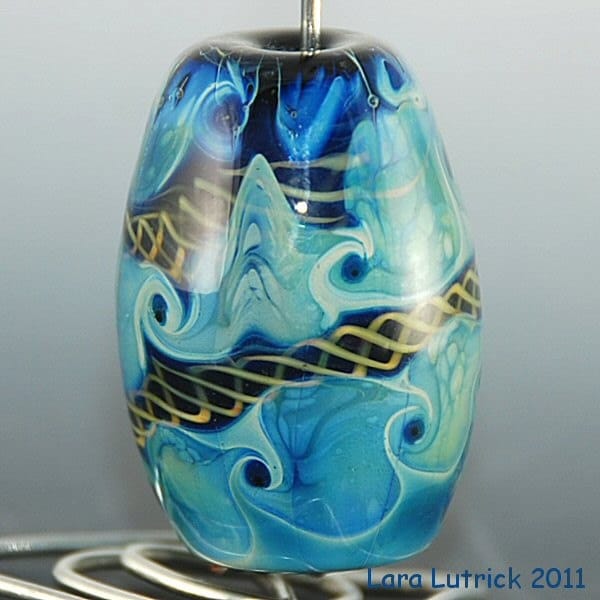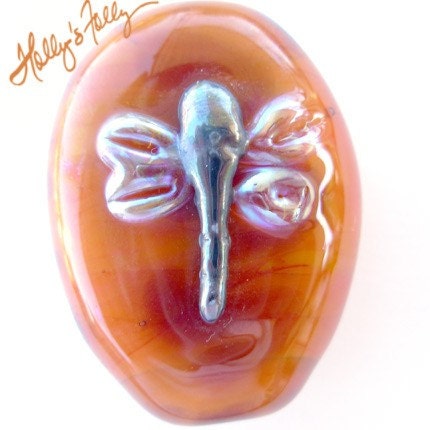This months question is actually very important and anyone that is serious about making beautiful, long lasting beads takes this subject quite seriously.
How can you tell the difference between an annealed bead and one that has not been kiln annealed?
And why does it matter?
Lara Lutrick
The only way to tell is if it breaks. You can not tell just by looking. However, there maybe some clues on poorly made beads that may lead you to believe that it is not annealed. If the bead has bead release still  in the hole (not just a bit left, but all of the release) chances are it was made in India or China and may not have been annealed.
in the hole (not just a bit left, but all of the release) chances are it was made in India or China and may not have been annealed. Same goes with uneven or poorly decorated designs.
It is important to kiln anneal as making the bead introduces stress into the glass and the kiln helps the glass cool down evenly andreduce the stress. Reduced stress = less chance of cracking.
Patrice Shepherd
 The naked eye cannot tell the difference, but you can use a polariscope if you have one laying around :) (kidding!) A dead giveaway for me is acute angles, where decorations are added on quickly and not melted in sufficiently, like dots and lines. If you hit these just a little bit, they will crack off. Another sign is the bail on a pendant, if it is not melted in enough, it's probably not been annealed either, as if someone didn't take the time to seal the bail on well enough, they probably didn't care to slow-cool it either!
The naked eye cannot tell the difference, but you can use a polariscope if you have one laying around :) (kidding!) A dead giveaway for me is acute angles, where decorations are added on quickly and not melted in sufficiently, like dots and lines. If you hit these just a little bit, they will crack off. Another sign is the bail on a pendant, if it is not melted in enough, it's probably not been annealed either, as if someone didn't take the time to seal the bail on well enough, they probably didn't care to slow-cool it either!
Annealing is an important step for glass art meant to last. We cherish our own beads and pendants, and expect this crucial step to be used for art-quality glass items. The slow-cooling of the annealing process is needed to relieve invisible stress that's left over from the melting and manipulating we do in the flame.
Holly Dare
The fact that you cannot tell by the naked eye is the very reason you should KNOW your bead maker when dealing with glass beads! An artist cares about their reputation and values their end product. The factories where they crank them out, don't; Another buyer looking for cheap crap will be along any second.

As a jewelry designer, you have to consider your own reputation. Do you make pieces to last a lifetime? How would you feel if a customer came back with broken beads?
 in the hole (not just a bit left, but all of the release) chances are it was made in India or China and may not have been annealed. Same goes with uneven or poorly decorated designs.
in the hole (not just a bit left, but all of the release) chances are it was made in India or China and may not have been annealed. Same goes with uneven or poorly decorated designs. The naked eye cannot tell the difference, but you can use a polariscope if you have one laying around :) (kidding!) A dead giveaway for me is acute angles, where decorations are added on quickly and not melted in sufficiently, like dots and lines. If you hit these just a little bit, they will crack off. Another sign is the bail on a pendant, if it is not melted in enough, it's probably not been annealed either, as if someone didn't take the time to seal the bail on well enough, they probably didn't care to slow-cool it either!Holly Dare
The naked eye cannot tell the difference, but you can use a polariscope if you have one laying around :) (kidding!) A dead giveaway for me is acute angles, where decorations are added on quickly and not melted in sufficiently, like dots and lines. If you hit these just a little bit, they will crack off. Another sign is the bail on a pendant, if it is not melted in enough, it's probably not been annealed either, as if someone didn't take the time to seal the bail on well enough, they probably didn't care to slow-cool it either!Holly Dare 












These are all amazing points- I think though that the fool proof method of detecting is just as Holly says- know your bead maker!
ReplyDeleteI have never had a bead from a reputable artist crack- at least not from unknown stresses!